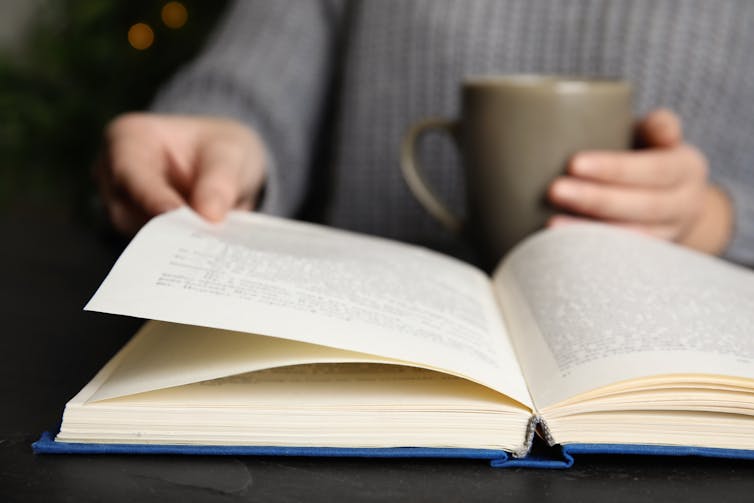
(Flip Mishevski/Unsplash)
Karen Bourrier, University of CalgaryEven in the 21st century, women writers are often consigned to what American novelist Meg Wolitzer has called “the second shelf.” Women’s novels are designed and marketed with a female audience in mind and publishers still presume that novels about women won’t appeal to male readers. Unfortunately, even in 2021 there may be some truth to this presumption.
This sexism can be seen in the continued speculation that female-identifying novelist Elena Ferrante is actually a man.
Vanity Fair contributing editor and book columnist Elissa Schappell summarized the assumptions behind the speculation: the novelist’s prolific output of “serious” books that interweave history, politics, violence, sex and domestic life, while “unflinchingly showing women in an unflattering light.”
Books by female-identifying authors are also less likely to be reviewed in prestigious literary magazines. In 2019, more than 60 per cent of reviews in magazines including London Review of Books, The Atlantic, and Harper’s, were of books written by men. This is actually an improvement since 2010, when between 69 per cent and 80 per cent of reviews in these magazines were of male-authored books.
The popular #readwomen hashtag on Twitter has been one response to the marginalization of women authors or sexism about their work. The social network website Goodreads can also provide insight into what women are reading.
Reading women
My collaborative research with data science professor Mike Thelwall has explored the reading habits of a cohort of mostly female readers (76 per cent) on the popular social network site Goodreads. As a group, Goodreads users also skew younger, whiter and more educated than the general population.
We examined what books readers read on Goodreads compared to what university professors assign in the classroom, using data from the Open Syllabus Project.
In past decades, researchers relied on handwritten diaries, letters and surveys of readers to find out how everyday readers responded to the books they read. Goodreads, which collects book reviews and ratings from 90 million members, offers one portal into reading habits.
On average, women Goodreads users read twice as much as male Goodreads users, and are more willing to read books by both male and female authors.
We scraped data from Goodreads and found that most Goodreads book club members were likely to have read books in common by women authors.
These women authors fell into two categories: young adult authors (J.K. Rowling, Suzanne Collins, Stephanie Meyer and Veronica Roth) and 19th- or early 20th-century authors (Jane Austen and Harper Lee). The popularity of young adult series by women, including the Harry Potter and Hunger Games series, means that 13 of the 19 most popular titles are by women.

(Shutterstock)
Compared to what professors teach
In a second study, we compared what books Goodreads users read to what university professors assign in the classroom, using data from the Open Syllabus Project. The Open Syllabus Project originated at Columbia University. It amasses syllabi, or college reading lists, from openly accessible university websites. Open Syllabus currently has a corpus of over nine million syllabi from 140 countries.
Our study focused on Victorian literature, literature published during Queen Victoria’s reign (1837-1901), which is both commonly taught at the university level and still read by general readers.
For the most part, we found that Goodreads users read books — including classic works by Charles Dickens, Arthur Conan Doyle and Oscar Wilde — about as often as university professors taught them.
However, we also found that the books that Goodreads users read more often than they were assigned in university tended to be by women writers, to feature strong female protagonists and to be aimed at a young adult audience — or all three.
Taking women writers seriously
This research is important because it suggests that professors who want to connect to students should take women writers more seriously.
Women writers show up less often than male writers on university syllabi. A survey conducted at McGill University in 2018 showed that 73 per cent of writers assigned on the university’s English literature syllabi are men.
Unfortunately, this is no surprise: English Prof. John Guillory’s work on canon formation captures the state of college English classes 30 years ago (and sometimes even more recently) when it was not uncommon for English professors to teach only white men.
Works by women writers are formative for many readers. For example, Wuthering Heights and Jane Eyre are often among the first “adult” novels that young English-language readers read. Their combination of romance and strong female protagonists continues to appeal to 21st-century readers outside the classroom.
Our study also showed that Frances Hodgson Burnett’s The Secret Garden and A Little Princess, and Lewis Carroll’s Alice’s Adventures in Wonderland — three works of young adult fiction featuring girls — were also read more on Goodreads than we would predict given how often they were assigned on syllabi.
It is more than time that publishers, book reviewers and university professors give women writers the respect they deserve. In an era of declining English majors when most English majors are women, English departments can at least start by assigning more women writers.![]()
Karen Bourrier, Associate Professor of English, University of Calgary
This article is republished from The Conversation under a Creative Commons license. Read the original article.




You must be logged in to post a comment.